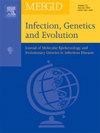三种不同形式的肺囊虫共存于两种鹿鼠(鹿鼠属)的个体。
IF 2.6
4区 医学
Q3 INFECTIOUS DISEASES
引用次数: 0
摘要
由于新出现的人畜共患病代表了重大的公共卫生威胁,了解病原体的宿主范围如何演变对于保护人类和野生动物的健康至关重要。受宿主特异性病原体感染的密切相关宿主为明确推断宿主范围进化提供了宝贵的机会,因为它们允许检查其常驻病原体的早期多样化模式。肺囊虫,一种在哺乳动物中普遍存在的专性肺共生体,就是这种模式的例证。为了探索肺囊虫分化的早期阶段,我们从鹿鼠的两个姊妹种:白足鼠Peromyscus leucopus和棉鼠Peromyscus gossypinus中收集了地理上分散的样本。我们对从这些小鼠的肺部取样的肺囊虫的两个核位点和两个线粒体位点进行了测序。这些序列揭示了三个不同的肺囊虫分类群,其中两个被发现交叉感染两个宿主物种,并且经常在同一个体中共存。遗传多样性和系统发育分析表明,这三个肺囊虫分类群代表不同的种。对这三个最常见分类群线粒体大亚基rRNA基因的进一步分析表明,宿主地理来源对肺囊虫遗传结构的影响大于宿主物种身份。尽管如此,结果也表明了共生元种群的整体互联性。本文章由计算机程序翻译,如有差异,请以英文原文为准。
Three distinct forms of Pneumocystis coexist in individuals of two species of deer mice (genus Peromyscus)
As emerging zoonoses represent a significant public health threat, understanding how pathogens' host ranges evolve is critical to protect human and wildlife health. Closely related hosts infected with host-specific pathogens provide valuable opportunities for clear inferences of host range evolution, as they allow for the examination of early diversification patterns in their resident pathogens. Pneumocystis, an obligate lung symbiont that is believed to be ubiquitous in mammals, exemplifies such a model. To explore the early stages of divergence in Pneumocystis, we collected geographically dispersed samples from two sister species of deer mice: Peromyscus leucopus (white-footed mice) and Peromyscus gossypinus (cotton mice). We sequenced two nuclear and two mitochondrial loci of Pneumocystis sampled from the lungs of these mice. These sequences revealed three distinct Pneumocystis taxa, two of which were found to cross-infect both host species and were often found coexisting within the same individual. Genetic diversity and phylogenetic analysis suggest that the three Pneumocystis taxa represent separate species. Further analysis of the mitochondrial large subunit rRNA gene from the most common taxon of these three revealed that host geographic origins influenced Pneumocystis genetic structure more than host species identity. Nevertheless, the results also suggest an overall interconnectedness of the symbiont metapopulation.
求助全文
通过发布文献求助,成功后即可免费获取论文全文。
去求助
来源期刊

Infection Genetics and Evolution
医学-传染病学
CiteScore
8.40
自引率
0.00%
发文量
215
审稿时长
82 days
期刊介绍:
(aka Journal of Molecular Epidemiology and Evolutionary Genetics of Infectious Diseases -- MEEGID)
Infectious diseases constitute one of the main challenges to medical science in the coming century. The impressive development of molecular megatechnologies and of bioinformatics have greatly increased our knowledge of the evolution, transmission and pathogenicity of infectious diseases. Research has shown that host susceptibility to many infectious diseases has a genetic basis. Furthermore, much is now known on the molecular epidemiology, evolution and virulence of pathogenic agents, as well as their resistance to drugs, vaccines, and antibiotics. Equally, research on the genetics of disease vectors has greatly improved our understanding of their systematics, has increased our capacity to identify target populations for control or intervention, and has provided detailed information on the mechanisms of insecticide resistance.
However, the genetics and evolutionary biology of hosts, pathogens and vectors have tended to develop as three separate fields of research. This artificial compartmentalisation is of concern due to our growing appreciation of the strong co-evolutionary interactions among hosts, pathogens and vectors.
Infection, Genetics and Evolution and its companion congress [MEEGID](http://www.meegidconference.com/) (for Molecular Epidemiology and Evolutionary Genetics of Infectious Diseases) are the main forum acting for the cross-fertilization between evolutionary science and biomedical research on infectious diseases.
Infection, Genetics and Evolution is the only journal that welcomes articles dealing with the genetics and evolutionary biology of hosts, pathogens and vectors, and coevolution processes among them in relation to infection and disease manifestation. All infectious models enter the scope of the journal, including pathogens of humans, animals and plants, either parasites, fungi, bacteria, viruses or prions. The journal welcomes articles dealing with genetics, population genetics, genomics, postgenomics, gene expression, evolutionary biology, population dynamics, mathematical modeling and bioinformatics. We also provide many author benefits, such as free PDFs, a liberal copyright policy, special discounts on Elsevier publications and much more. Please click here for more information on our author services .
 求助内容:
求助内容: 应助结果提醒方式:
应助结果提醒方式:


